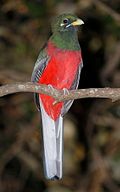Trogon
The trogons and quetzals are birds in the order Trogoniformes which has only one family, the Trogonidae. There are 39 living species in seven genera.
| Trogons Temporal range: Early Eocene,
| |
|---|---|

| |
| A male red-headed trogon in Khao Yai National Park, Thailand | |
| Red-naped trogon song, recorded near Bangar, Brunei | |
| Scientific classification | |
| Kingdom: | Animalia |
| Phylum: | Chordata |
| Clade: | Cavitaves |
| Clade: | Eucavitaves |
| Order: | Trogoniformes AOU, 1886 |
| Family: | Trogonidae Lesson, 1828 |
| Genera | |
|
Apaloderma | |

| |
| global distribution | |
The fossil record of the trogons dates back 49 million years to the mid-Eocene. The word "trogon" is Greek for "nibbling" and refers to the fact that these birds gnaw holes in trees to make their nests.
Trogons are residents of tropical forests worldwide. The greatest diversity is in the Neotropics, where four genera, with 24 species occur. The genus Apaloderma has the three African species. The genera Harpactes and Apalharpactes, with twelve species, live in southeast Asia.[1]
They feed on insects and fruit. Their broad bills and weak legs reflect their diet and arboreal habits. Although their flight is fast, they do not fly long distances. Trogons are generally not migratory. They have soft, often colourful, feathers with distinctive male and female plumage. They are the only type of animal with a heterodactyl toe arrangement. They nest in holes dug into trees or termite nests, laying 2–4 white or pastel-coloured eggs.
Trogon Media
Fossil of Masillatrogon from Messel
Skull of a trogon showing the presence of a basipterygoid process (bpg.p.) and a schizognathous palate
A male resplendent quetzal entering his nest.
References
- ↑ Collar N.J. 2001. Family Trogonidae (Trogons). In del Hoyo J; Elliot A. & Sargatal J. (eds) 2001. Handbook of the Birds of the World, vol. 6 Mousebirds to Hornbills, pp. 80–129. Lynx Edicions, Barcelona, Spain. ISBN 84-87334-30-X










